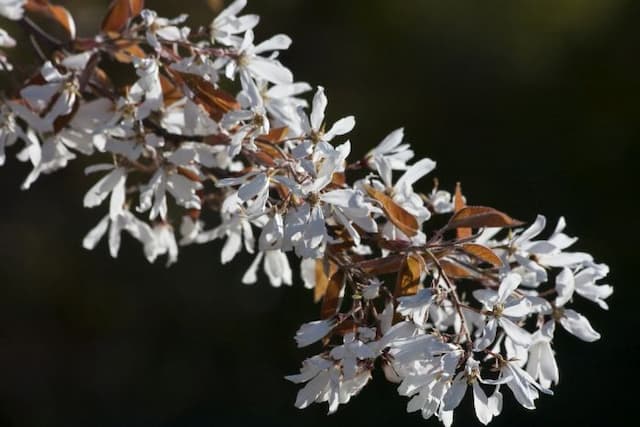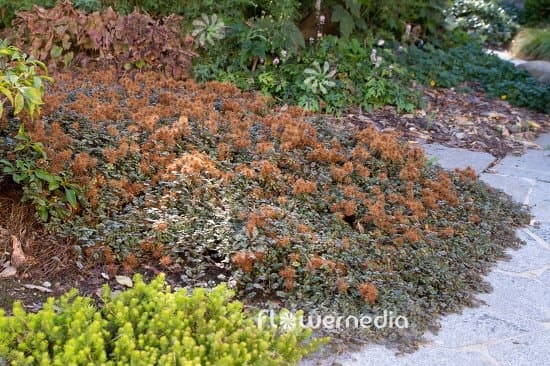Red Chokeberry Aronia arbutifolia 'Erecta'

ABOUT
The Aronia arbutifolia 'Erecta', commonly known as the Red Chokeberry, presents itself with a naturally upright habit, showcasing multiple stems that grow straight and tall. The leaves of the Red Chokeberry are deciduous, having a glossy, deep green color that turns to a striking red or purple in the fall, providing a seasonal display of vibrant colors. In spring, this plant is adorned with small clusters of white to light pink flowers, each with numerous delicate petals and a prominent center of pinkish stamens. These blooms are not only visually appealing, but they also attract various pollinators to the garden. Following the flowering season, the Red Chokeberry produces small red berries, which are quite tart to the taste but hold a high nutritional value. The fruits persist into the winter, offering a striking contrast against the winter landscape and providing a valuable food source for birds. The bark of this plant is also noteworthy, being a smooth gray that exudes a subtle elegance and provides winter interest long after the leaves have fallen. Overall, the Red Chokeberry is a plant that offers multi-season interest and is a visually striking addition to any garden setting.
About this plant
 Names
NamesFamily
Rosaceae
Synonyms
Red Chokeberry, Erect Red Chokeberry
Common names
Photinia pyrifolia, Pyrus arbutifolia, Sorbus arbutifolia.
 Toxicity
ToxicityTo humans
The Red Chokeberry is generally considered non-toxic to humans. However, ingesting any plant material can potentially cause mild stomach upset due to the presence of tannins or other plant compounds. It is always advisable to consume only plant parts that are known to be safe and edible.
To pets
The Red Chokeberry is not known to be toxic to pets. Like with humans, the consumption of plant parts not typically part of an animal's diet might lead to gastrointestinal distress or upset, but it does not cause serious poisoning or life-threatening symptoms in pets.
 Characteristics
CharacteristicsLife cycle
Perennials
Foliage type
Deciduous
Color of leaves
Green
Flower color
White
Height
6-8 feet (1.8-2.4 meters)
Spread
3-4 feet (0.9-1.2 meters)
Plant type
Shrub
Hardiness zones
4-9
Native area
North America
Benefits
 General Benefits
General Benefits- Wildlife Attraction: Aronia arbutifolia 'Erecta' produces berries that serve as a food source for birds and other wildlife, promoting biodiversity in the garden.
- Seasonal Interest: With its bright red fall foliage and red berries, it offers multi-seasonal interest in the landscape.
- Erosion Control: The plant's root system helps stabilize soil in areas prone to erosion.
- Low Maintenance: It is a hardy plant that requires minimal care once established, making it ideal for both novice and experienced gardeners.
- Privacy and Screening: Its dense, upright growth habit makes it suitable for use as a privacy screen or hedge.
- Drought Tolerance: Once established, it is tolerant of drought, reducing the need for frequent watering.
- Cultural Significance: It can be used in native plant gardens and to preserve regional flora, contributing to cultural and natural heritage.
- Pollinator Support: The flowers provide nectar for pollinators, helping to support bee and butterfly populations.
- Landscape Versatility: It can be planted in a variety of landscape settings, from wet areas to dry slopes.
- Adaptability: The plant is adaptable to a range of soil types, including clay, sand, and loam.
- Ornamental Fruit: The bright red berries provide ornamental value to the garden even after the leaves have fallen.
 Medical Properties
Medical Properties- This plant is not used for medical purposes.
 Air-purifying Qualities
Air-purifying QualitiesThis plant is not specifically known for air purifying qualities.
 Other Uses
Other Uses- Wildlife Shelter: Red chokeberry provides dense foliage and branches that offer shelter and nesting sites for birds and small mammals.
- Ink and Dye Production: The deep purple fruits can be processed to make natural dyes or inks for art and fabric coloring.
- Erosion Control: With its extensive root system, red chokeberry is effective at stabilizing soil and controlling erosion on slopes or embankments.
- Photography Attributes: The vibrant red berries and striking autumn foliage make red chokeberry a popular subject for nature photographers.
- Winter Interest: The vivid red fruit of the red chokeberry persists through winter, providing visual interest in barren landscapes.
- Culinary Experiments: While not common, the tart berries can be used in small quantities to add a unique flavor twist to jams, jellies, and sauces.
- Floral Arrangements: The branches with berries are often used by florists to add a splash of color to bouquets and floral decorations.
- Edible Landscaping: Red chokeberry is suited for edible landscaping, combining both aesthetic appeal and the potential for small-scale harvests.
- Natural Fencing: The shrub can be planted in rows to create a natural and visually appealing barrier that also supports wildlife.
- Traditional Crafts: The berries and plant parts can be incorporated into traditional crafts like wreath-making, especially during the holiday season.
Interesting Facts
 Feng Shui
Feng ShuiThe Red Chokeberry is not used in Feng Shui practice.
 Zodiac Sign Compitability
Zodiac Sign CompitabilityThe Red Chokeberry is not used in astrology practice.
 Plant Symbolism
Plant Symbolism- Resilience - Red Chokeberry 'Erecta' thrives in various conditions, symbolizing the ability to persevere through challenging environments.
- Protection - With its dense growth and the astringent taste of its berries deterring pests, this plant represents safeguarding and natural defense.
- Healing - The berries of the plant have antioxidant properties, making it a symbol of health and healing.
- Adaptability - Its adaptability to different soil types echoes flexibility and the capacity to thrive in diverse situations.
 Water
WaterThe Red Chokeberry should be watered deeply once a week during its first growing season to help establish a strong root system. After it is established, watering can become less frequent, but the soil should not be allowed to dry out completely. During dry spells, provide the plant with at least 1 to 2 gallons of water every two weeks. Remember to adjust the amount of water depending on the season and the rainfall; more water may be required during hot, dry summer months and less when the weather is cool or rainy.
 Light
LightRed Chokeberry thrives in full sunlight to partial shade. The ideal spot for this plant includes an area that receives at least 4 to 6 hours of direct sun daily, but it can also tolerate light shade. Avoid deep shade locations as this can affect the plant's flowering and fruiting performance.
 Temperature
TemperatureRed Chokeberry can withstand a wide range of temperatures, making it a hardy choice for many gardens. It can survive in temperatures as low as -20°F and as high as 100°F, but it performs best when the temperature remains between 60°F and 80°F. These temperature ranges allow the Red Chokeberry to produce abundant flowers and fruits.
 Pruning
PruningPrune the Red Chokeberry in late winter or early spring to remove any dead or damaged branches and to maintain its shape. Pruning can also rejuvenate an older plant if done correctly; cut back about one-third of the oldest stems to the ground every year. This plant typically doesn't require frequent pruning, so an annual checkup and trim should suffice.
 Cleaning
CleaningAs needed
 Soil
SoilRed Chokeberry 'Erecta' thrives in moist, well-draining soil rich in organic matter with a soil pH range of 4.5 to 7.0. A blend of loamy garden soil, peat moss, and sand or perlite in equal parts can create an optimal growing medium. Regular mulching helps maintain soil moisture and organic content.
 Repotting
RepottingRed Chokeberry 'Erecta' is not typically grown in containers and generally does not require repotting as it is a landscape shrub. Instead, it is planted directly in the ground where it can spread and does not need frequent transplantation.
 Humidity & Misting
Humidity & MistingRed Chokeberry 'Erecta' is adaptable and does not require specific humidity levels; it grows well in outdoor conditions where the natural atmosphere provides adequate humidity.
 Suitable locations
Suitable locationsIndoor
Place in bright light, keep soil moist, not too warm.
Outdoor
Full sun to part shade, moist soil, mulch well.
Hardiness zone
4-9 USDA
 Life cycle
Life cycleThe Red Chokeberry 'Erecta' begins its life cycle when seeds germinate, typically requiring stratification to break dormancy. Seedlings establish themselves and gradually transition into juvenile plants, putting forth leaves and developing a root system. As the plant matures, it enters the vegetative stage, characterized by the growth of upright, branching stems and glossy green leaves. Upon reaching maturity, it enters the reproductive phase, blooming with clusters of white to light pink flowers in the spring, which then develop into red berries by late summer into fall. The plant continually grows and can reproduce annually, with flowers and fruit production being a major part of its yearly cycle. In winter, the plant may enter dormancy, losing leaves in colder climates, but it remains hardy and resumes growth with the return of warmer temperatures in the spring.
 Propogation
PropogationPropogation time
Late Winter
The Red Chokeberry 'Erecta' can be propagated through various methods, but the most popular is through softwood cuttings. In early to mid-summer, when new growth is still tender, cuttings of about 5 to 8 inches (approximately 13 to 20 centimeters) long are taken from the current year's growth. The leaves on the lower half of the cutting should be removed, and the bottom end is dipped in rooting hormone to encourage root development. The cuttings are then inserted into a well-draining potting mix, ensuring that at least two to three nodes are buried where leaves were removed. To maintain high humidity, which is crucial for rooting success, a clear plastic bag or domed cover can be placed over the cuttings. The cutting should be kept in indirect light and should not be allowed to dry out. In several weeks, once the roots have formed and the plant has started to show new growth, the new Red Chokeberry plants can be transplanted into individual pots or into the garden.









